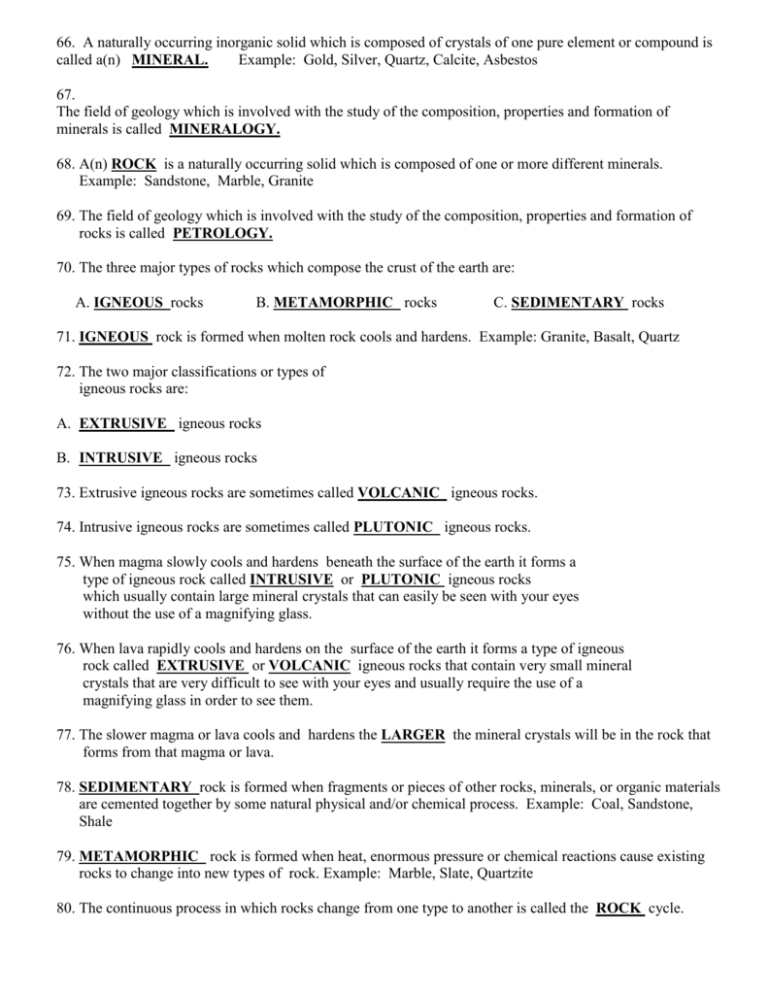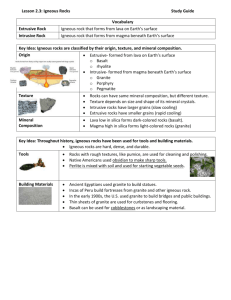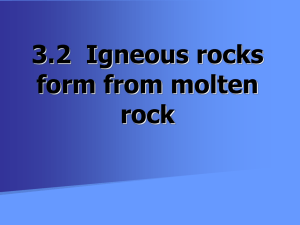66. A naturally occurring inorganic solid which is composed of
advertisement

66. A naturally occurring inorganic solid which is composed of crystals of one pure element or compound is called a(n) MINERAL. Example: Gold, Silver, Quartz, Calcite, Asbestos 67. The field of geology which is involved with the study of the composition, properties and formation of minerals is called MINERALOGY. 68. A(n) ROCK is a naturally occurring solid which is composed of one or more different minerals. Example: Sandstone, Marble, Granite 69. The field of geology which is involved with the study of the composition, properties and formation of rocks is called PETROLOGY. 70. The three major types of rocks which compose the crust of the earth are: A. IGNEOUS rocks B. METAMORPHIC rocks C. SEDIMENTARY rocks 71. IGNEOUS rock is formed when molten rock cools and hardens. Example: Granite, Basalt, Quartz 72. The two major classifications or types of igneous rocks are: A. EXTRUSIVE igneous rocks B. INTRUSIVE igneous rocks 73. Extrusive igneous rocks are sometimes called VOLCANIC igneous rocks. 74. Intrusive igneous rocks are sometimes called PLUTONIC igneous rocks. 75. When magma slowly cools and hardens beneath the surface of the earth it forms a type of igneous rock called INTRUSIVE or PLUTONIC igneous rocks which usually contain large mineral crystals that can easily be seen with your eyes without the use of a magnifying glass. 76. When lava rapidly cools and hardens on the surface of the earth it forms a type of igneous rock called EXTRUSIVE or VOLCANIC igneous rocks that contain very small mineral crystals that are very difficult to see with your eyes and usually require the use of a magnifying glass in order to see them. 77. The slower magma or lava cools and hardens the LARGER the mineral crystals will be in the rock that forms from that magma or lava. 78. SEDIMENTARY rock is formed when fragments or pieces of other rocks, minerals, or organic materials are cemented together by some natural physical and/or chemical process. Example: Coal, Sandstone, Shale 79. METAMORPHIC rock is formed when heat, enormous pressure or chemical reactions cause existing rocks to change into new types of rock. Example: Marble, Slate, Quartzite 80. The continuous process in which rocks change from one type to another is called the ROCK cycle.








